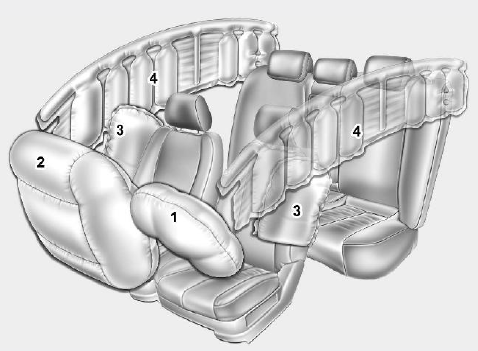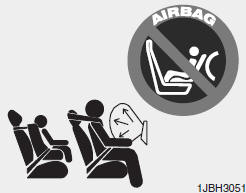 Hyundai Elantra MD/UD: Air bag - advanced supplemental restraint system
Hyundai Elantra MD/UD: Air bag - advanced supplemental restraint system

* The actual air bags in the vehicle may differ from the illustration.
(1) Driver’s front air bag
(2) Passenger’s front air bag
(3) Side impact air bag (if equipped)
(4) Curtain air bag (if equipped)
![]() WARNING
WARNING
Even in vehicles with air bags, you and your passengers must always wear the seat belts provided in order to minimize the risk and severity of injury in the event of a collision or rollover.
How does the air bag system operate
- Air bags are activated (able to inflate if necessary) only when the ignition switch is turned to the ON or START position.
- Air bags inflate instantly in the event of serious frontal or side collision in order to help protect the occupants from serious physical injury.
- There is no single speed at which the air bags will inflate. Generally, air bags are designed to inflate by the severity of a collision and its direction. These two factors determine whether the sensors send out an electronic deployment/ inflation signal.
- Air bag deployment depends on a number of factors including vehicle speed, angles of impact and the density and stiffness of the vehicles or objects which your vehicle hits in the collision. Though, factors are not limited to those mentioned above.
- The front air bags will completely inflate and deflate in an instant. It is virtually impossible for you to see the air bags inflate during an accident. It is much more likely that you will simply see the deflated air bags hanging out of their storage compartments after the collision.
- In order to help provide protection in a severe collision, the air bags
must inflate rapidly. The speed of air bag inflation is a consequence of the
extremely short time in which a collision occurs and the need to get the air
bag between the occupant and the vehicle structures before the occupant impacts
those structures. This speed of inflation reduces the risk of serious or lifethreatening
injuries in a severe collision and is thus a necessary part of air bag design.
However, air bag inflation can also cause injuries which normally can include facial abrasions, bruises and broken bones because the inflation speed also causes the air bags to expand with a great deal of force. - There are even circumstances under which contact with the air bag can cause fatal injuries, especially if the occupant is positioned excessively close to the air bag.
![]() WARNING
WARNING
- To avoid severe personal injury or death caused by deploying air bags in a collision, the driver should sit as far back from the steering wheel air bag as possible (at least 10 inches (250 mm) away). The front passengers should always move their seats as far back as possible and sit back in their seat.
- Air bags inflate instantly in the event of collision, and passengers may be injured by the air bag expansion force if they are not in proper position.
- Air bag inflation may cause injuries which normally include facial or bodily abrasions, injuries from broken glasses or burns by the air bag inflation gasses.
Noise and smoke
When the air bags inflate, they make a loud noise and they leave smoke and powder in the air inside of the vehicle. This is normal and is a result of the ignition of the air bag inflator. After the air bag inflates, you may feel substantial discomfort in breathing due to the contact of your chest with both the seat belt and the air bag, as well as from breathing the smoke and powder. Open your doors and/or windows as soon as possible after impact in order to reduce discomfort and prevent prolonged exposure to the smoke and powder.
Though the smoke and powder are nontoxic, they may cause irritation to the skin (eyes, nose and throat, etc). If this is the case, wash and rinse with cold water immediately and consult a doctor if the symptom persists.
![]() WARNING
WARNING
When the air bags deploy, the air bag related parts in the steering wheel and/or instrument panel and/or in both sides of the roof rails above the front and rear doors are very hot. To prevent injury, do not touch the air bag storage area’s internal components immediately after an air bag has inflated.
Do not install a child restraint on the front passenger’s seat.

Never place a rear-facing child restraint in the front passenger’s seat. If the air bag deploys, it would impact the rear-facing child restraint, causing serious or fatal injury.
In addition, do not place front-facing child restraints in the front passenger’s seat either. If the front passenger air bag inflates, it could cause serious or fatal injuries to the child.
![]() WARNING
WARNING
Extreme Hazard! Do not use a rearward facing child restraint on a seat protected by an air bag in front of it!
Never put a child restraint in the front passenger’s seat. If the front passenger air bag inflates, it would cause serious or fatal injuries.
When children are seated in the rear outboard seats of a vehicle equipped with side air bags, be sure to install the child restraint system as far away from the door side as possible, and securely lock the child restraint system in position.
Inflation of side and/or curtain air bags could cause serious injury or death to an infant or child.
- Air bag warning light
- SRS components and functions
- Occupant classification system
- Main components of occupant classification system
- Driver's and passenger's front air bag
- Side impact air bag (if equipped)
- Curtain air bag (if equipped)
- Why didn’t my air bag go off in a collision? (Inflation and non-inflation conditions of the air bag)
- SRS Care
- Additional safety precautions
- Adding equipment to or modifying your air bag-equipped vehicle
- Air bag warning label (if equipped)


